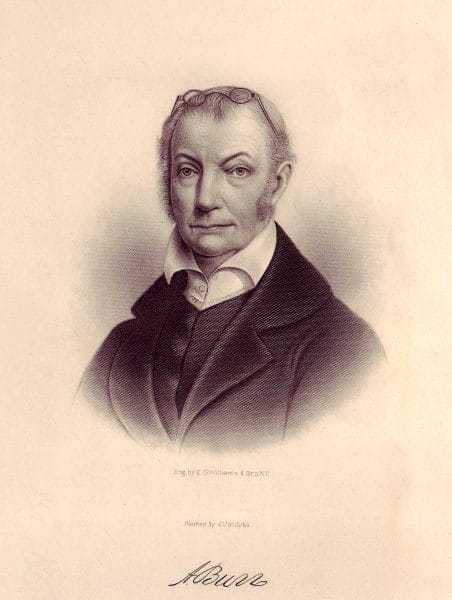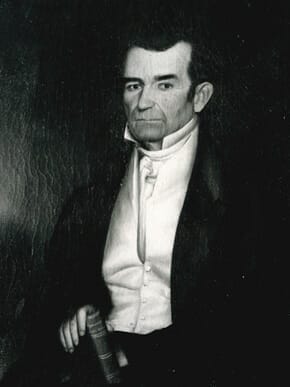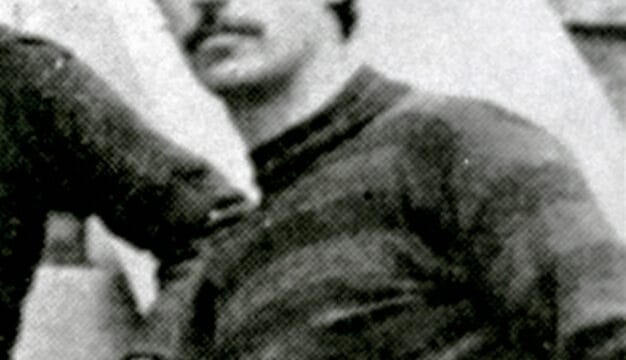Aaron Burr's Arrest
 Aaron Burr
On February 19, 1807, Aaron Burr, the former vice president of the United States, was arrested near the town of McIntosh by Capt. Edmund P. Gaines in Washington County, in what is now Alabama. Burr was fleeing a call for his capture by Pres. Thomas Jefferson on charges that he was threatening the security of the United States by raising troops to conquer Spanish territories in North America. His supporters were equally steadfast in their belief that he was either leading an expedition to colonize lands he had purchased along the Sabine River, organizing a group of filibusterers to conquer Texas and Mexico, or planning an attack on Spanish West Florida. Burr’s arrest led to his trial for treason and subsequent acquittal in Richmond, Virginia.
Aaron Burr
On February 19, 1807, Aaron Burr, the former vice president of the United States, was arrested near the town of McIntosh by Capt. Edmund P. Gaines in Washington County, in what is now Alabama. Burr was fleeing a call for his capture by Pres. Thomas Jefferson on charges that he was threatening the security of the United States by raising troops to conquer Spanish territories in North America. His supporters were equally steadfast in their belief that he was either leading an expedition to colonize lands he had purchased along the Sabine River, organizing a group of filibusterers to conquer Texas and Mexico, or planning an attack on Spanish West Florida. Burr’s arrest led to his trial for treason and subsequent acquittal in Richmond, Virginia.
On July 11, 1804, Vice Pres. Aaron Burr fought a duel with rival Alexander Hamilton in Weehawken, New Jersey. Hamilton died of wounds sustained in the duel, and Burr fled briefly before returning to his duties as vice president. During this time, Burr, who was something of an outcast among the Jeffersonian Democrats because of his manipulations to secure the presidency, had turned his attentions west, hatching a plan to invade Spanish territories with an army. After his term of office ended in March 1805, Burr entered into correspondence with Gen. James Wilkinson, paid for the construction of ships, and provisioned them with supplies and concealed arms. Wilkinson was a double agent who had been in the service of Spain since the 1780s. On November 5, a warrant was issued for Burr’s appearance at court in Frankfort, Kentucky, on the charge that Burr threatened to open hostilities between the United States and Spain. Burr was arrested in Lexington, Kentucky, on December 6, 1806, and defended in his trial by Henry Clay. Released for lack of evidence, Burr descended the Cumberland and Mississippi rivers with 13 boats and 60 men. Pres. Thomas Jefferson was warned of rumors that Burr intended to split the country and issued a proclamation on November 27 calling for his apprehension. This was echoed by similar proclamations from several governors.
 Nicholas Perkins III
The events surrounding Burr’s capture in what is now south Alabama were recorded in several contemporary sources, most notable the verbal testimony of Nicholas Perkins in Burr’s 1807 trial and in letters written by some of the principals, including Lieutenant Gaines and Burr’s traveling companion, Robert Ashley. According to these sources, on the night of February 18, at approximately 11 o’clock that evening, Perkins was standing in front of Sheriff Theodore Brightwell’s house in the upper end of the Wakefield settlement in Washington County, in what was then Mississippi Territory, when he saw two travelers on the road in the moonlight. The first, who would turn out to be Aaron Burr, passed without stopping or speaking, but his companion Robert Ashley, stopped and asked for directions to Maj. John Hinson’s home. Perkins directed him but noted that Hinson was not at home and that high creek water might make the journey difficult. This did not appear to deter the pair, who proceeded on their way.
Nicholas Perkins III
The events surrounding Burr’s capture in what is now south Alabama were recorded in several contemporary sources, most notable the verbal testimony of Nicholas Perkins in Burr’s 1807 trial and in letters written by some of the principals, including Lieutenant Gaines and Burr’s traveling companion, Robert Ashley. According to these sources, on the night of February 18, at approximately 11 o’clock that evening, Perkins was standing in front of Sheriff Theodore Brightwell’s house in the upper end of the Wakefield settlement in Washington County, in what was then Mississippi Territory, when he saw two travelers on the road in the moonlight. The first, who would turn out to be Aaron Burr, passed without stopping or speaking, but his companion Robert Ashley, stopped and asked for directions to Maj. John Hinson’s home. Perkins directed him but noted that Hinson was not at home and that high creek water might make the journey difficult. This did not appear to deter the pair, who proceeded on their way.
Perkins became suspicious of the men, given their late hour of travel, Burr’s silence, and the unwillingness of the pair to stop at an inn, even when they were told of the high water and Hinson’s absence. Believing that they were robbers, or possibly the fugitive Burr and a friend, Perkins roused Sheriff Brightwell and convinced him to ride to Hinson’s home. When they arrived, Perkins spoke with Ashley, and Burr, who had been warming himself in the kitchen, came into the room where the other men were. He spoke little and avoided observation but seemed to be interested in whether he was being watched. Convinced of Burr’s identity, Perkins decided to plan for his capture. He left the house after mentioning the direction he planned to take, one opposite to that he thought Burr might take. Out of eyeshot, he took the road to Fort Stoddert, where he informed the commandant, Lt. Edmund P. Gaines, of his suspicions.
 Edmund P. Gaines
Perkins and Gaines left the fort with several other men the following morning. After starting out about 14 miles north, the pursuers met with Burr, who was being escorted by Sheriff Brightwell to the ferry on the Tombigbee River. Burr planned to stop and wait there for his servants and baggage, which had lagged behind. According to some sources, Burr planned to travel to Pensacola and from there to Europe to enlist British and French support in the conquest of Spain’s North American territories. Ashley, who was not present when Burr was seized, later claimed that Burr was heading toward Washington, D.C. Gaines detained Burr, based on the proclamations of the president and the territorial governor, and escorted him back to Fort Stoddert. Ashley, who told Perkins that he had met Burr on the road and decided to travel with him, was allowed to continue on his way, as was Brightwell. Burr remained at the fort for the rest of February. After arrangements were made, Burr was placed under a military guard headed by Gaines in early March and taken by boat up the Alabama River into Lake Tensaw in Baldwin County. After the party landed, Burr was delivered to an escort party headed by Perkins for the journey to Richmond, Virginia, where he was tried and acquitted on September 1, 1807.
Edmund P. Gaines
Perkins and Gaines left the fort with several other men the following morning. After starting out about 14 miles north, the pursuers met with Burr, who was being escorted by Sheriff Brightwell to the ferry on the Tombigbee River. Burr planned to stop and wait there for his servants and baggage, which had lagged behind. According to some sources, Burr planned to travel to Pensacola and from there to Europe to enlist British and French support in the conquest of Spain’s North American territories. Ashley, who was not present when Burr was seized, later claimed that Burr was heading toward Washington, D.C. Gaines detained Burr, based on the proclamations of the president and the territorial governor, and escorted him back to Fort Stoddert. Ashley, who told Perkins that he had met Burr on the road and decided to travel with him, was allowed to continue on his way, as was Brightwell. Burr remained at the fort for the rest of February. After arrangements were made, Burr was placed under a military guard headed by Gaines in early March and taken by boat up the Alabama River into Lake Tensaw in Baldwin County. After the party landed, Burr was delivered to an escort party headed by Perkins for the journey to Richmond, Virginia, where he was tried and acquitted on September 1, 1807.
Many picturesque local legends developed around Burr’s arrest in Alabama. Historian Albert James Pickett documented many of them in his 1851 History of Alabama. He claimed to have spoken or corresponded with several eyewitnesses of the events, but his research was undertaken many years later. The facts as narrated by him differ in several important particulars from contemporary sources.
Further Reading
- Abernathy, Thomas Perkins. The Burr Conspiracy. New York: Oxford University Press, 1954.
- McCaleb, Walter Flavius. The Aaron Burr Conspiracy and a New Light on Aaron Burr. New York: Argosy-Antiquarian, 1966.
- Pickett, Albert James. “The Capture of Aaron Burr.” American History 1 (April 1896): 140-53.
- Welborn, Aaron. “A Traitor in the Wilderness: The Arrest of Aaron Burr,” Alabama Heritage 83 (Winter 2007).



